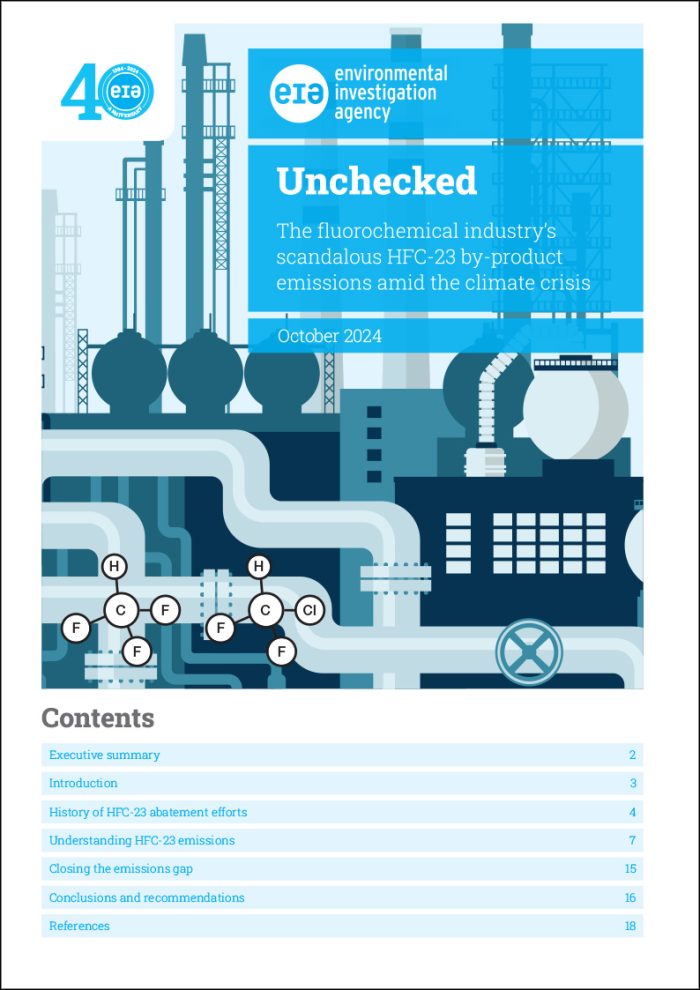Critical climate targets are being jeopardised by rogue HFC-23 greenhouse gas emissions



The world’s pressing climate targets are being jeopardised by huge rogue emissions of a potent greenhouse gas.
HFC-23 emissions reached a record high of 17,300 tonnes in 2019, equivalent to more than a quarter of a billion tonnes of carbon dioxide.
The climate super-pollutant is produced and emitted primarily as an unwanted byproduct of manufacturing HCFC-22, an ozone-depleting substance which is controlled globally by the Montreal Protocol. HCFC-22, in turn, is mostly used to produce fluoropolymers such as PTFE (Teflon).
 On the eve of the 36th Meeting of the Parties (MoP36) to the Montreal Protocol, taking place in Bangkok from 28 October, EIA has warned that the failure to address these emissions lies primarily with lax monitoring and reporting which has allowed the damaging activities of the fluorochemical industry to continue unchecked.
On the eve of the 36th Meeting of the Parties (MoP36) to the Montreal Protocol, taking place in Bangkok from 28 October, EIA has warned that the failure to address these emissions lies primarily with lax monitoring and reporting which has allowed the damaging activities of the fluorochemical industry to continue unchecked.
HFC-23 can be captured and destroyed at relatively low cost to prevent emissions. But despite billions of previous investment in the chemical industry via the UN Framework Convention on Climate Change’s carbon trading scheme and, more recently, a requirement under the 2016 Kigali Amendment to the Montreal Protocol to capture and destroy the gas, recent assessments indicate that emissions are far higher than anticipated, particularly from China which accounts for nearly half of the global HFC-23 emissions gap from 2015-22.
The new EIA report Unchecked — The fluorochemical industry’s scandalous HFC-23 by-product emissions amid the climate crisis, estimates that cumulative emissions of HFC-23 since 2016 are almost 106,000 tonnes, equivalent to 1.56 billion tonnes of CO2 — or the same climate damage as driving more than 371 million petrol-powered cars for a year.
EIA UK Climate Campaign Leader Clare Perry said: “Our planetary system can ill afford such reckless and pointless greenhouse gas emissions, coming from an industry that has been subsidised to the tune of billions of dollars. The fluorochemical industry has flown under the radar for far too long, it’s time for some accountability.”
EIA UK Climate Campaigner Dr Joanna Sparks added: “Scientific studies have shed light on the massive scale of HFC-23 emissions, but we still can’t identify the actual sources of about 75% of the emissions, making it hard to hold emitters to account. While China is clearly a major source, there are still significant gaps in the atmospheric data for other parts of the world which must be addressed.”
EIA is calling for a strong response from the Parties to the Montreal Protocol when they meet in Bangkok, including demanding greater transparency and provision of information from countries with fluoropolymer and HCFC-22 production, the establishment of clear guidelines for measuring and reporting HFC-23 emissions and efforts from all countries to reduce emissions from ongoing uses of HFC-23.